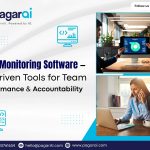Productivity has always been a core business metric — but in today’s hybrid work culture, simply tracking hours worked isn’t enough. Companies need to know how those hours are spent and what value is being delivered.
An AI-powered productivity tracker takes this to the next level — combining attendance data, task tracking, and behavioral analytics into a single, intelligent platform. Integrated with employee monitoring software and face recognition attendance systems, it provides a real-time view of performance that managers can actually act on.
What is an AI-Powered Productivity Tracker?
It’s a software tool that uses artificial intelligence to:
- Track time spent on projects and apps
- Measure output against expected benchmarks
- Analyze patterns and behaviors to identify productivity trends
- Deliver recommendations for improvement
Unlike traditional time trackers, AI tools understand context — they can distinguish between productive and non-productive activities, even when employees switch tasks frequently.
Key Features of AI Productivity Trackers
1. Automated Time Tracking
AI logs activity without manual input, reducing errors and time theft.
2. App & Website Categorization
Classifies apps/sites as productive, neutral, or unproductive based on role-specific settings.
3. Task Performance Analytics
Links task completion data with employee attendance management systems for complete productivity profiling.
4. AI-Powered Insights & Alerts
Identifies performance bottlenecks and suggests workflow improvements.
5. Integration with Attendance & Monitoring Tools
Works seamlessly with face attendance machines, employee tracking apps, and staff monitoring software.
Benefits of AI-Powered Productivity Trackers
1. Objective Performance Measurement
Move away from guesswork and rely on data-backed evaluations.
2. Improved Efficiency
AI reveals hidden inefficiencies — such as excessive idle time or repetitive manual work.
3. Employee Self-Improvement
Dashboards allow employees to monitor and optimize their own productivity.
4. Data-Driven Management
Managers can focus on strategic improvements instead of micromanaging.
Integration for a Unified Productivity Ecosystem
When connected with other AI tools, productivity trackers create a holistic performance view:
- Face recognition attendance systems → Confirms verified work hours
- Employee monitoring software → Captures activity patterns
- Employee tracking apps → Adds location-based context
- Staff monitoring software → Delivers performance scores across teams
AI Innovations in Productivity Tracking
- Focus Pattern Recognition: Detects when employees are most productive and suggests optimal work schedules
- Predictive Performance Analysis: Forecasts outcomes based on current performance trends
- Automated Task Allocation: Assigns tasks dynamically to balance workload
- Emotion & Stress Detection: Uses webcam and biometric integrations to flag burnout risks
Industry Applications
1. IT & Software Development
Tracks coding hours, bug fixes, and deployment timelines.
2. Marketing Teams
Measures creative output and campaign management efficiency.
3. Call Centers
Monitors talk time, response speed, and customer satisfaction metrics.
4. Field Teams
Combines GPS from employee tracking apps with task logs for a complete productivity picture.
Privacy & Ethical Considerations
- Clearly define what’s being tracked and why
- Use aggregated data for team-level analysis, not just individual micromanagement
- Protect personal data with encryption and secure cloud storage
- Align with workplace privacy laws
The Future of AI Productivity Tracking
- Hyper-Personalized Coaching: AI provides individual improvement tips
- Cross-Tool Integration: Unified dashboards combining attendance, tracking, and project management
- Proactive Burnout Prevention: AI alerts managers before performance drops
- Gamification: Turning productivity into friendly competition with leaderboards
Conclusion: Turning Data into Productivity Gains
An AI-powered productivity tracker isn’t just a monitoring tool — it’s a performance coach that helps businesses get the most from their teams while empowering employees to improve on their own.
When integrated with face recognition attendance systems, employee tracking apps, and staff monitoring software, it forms a complete ecosystem that tracks attendance, activity, location, and performance in real time.


